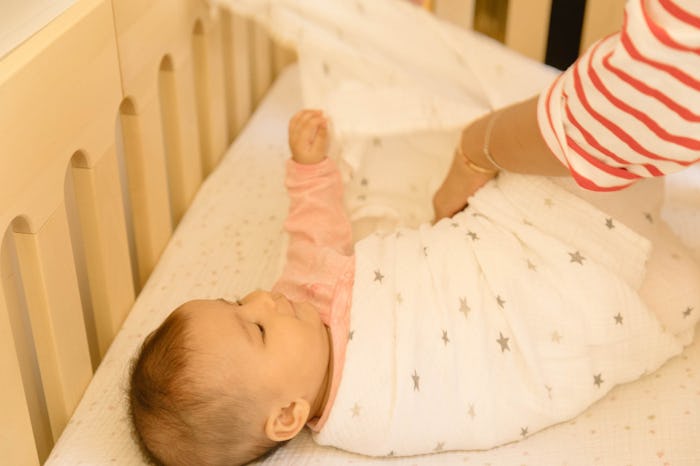Parents, nurses, and caregivers all around the world turn to swaddling to comfort fussy babies. It's no secret that newborns like being wrapped snug as a bug in a rug, but as a new parent arguably on your own once you take your baby home, it can be difficult to determine what's really the best choice for you and your baby. So, is swaddling safe? Turns out, and just like almost any other parenting decision you're sure to make, there are a few things to consider.
Swaddling, which is the act of wrapping a baby in a blanket or large patch of fabric to mimic the womb, is universally practiced. According to HealthyChidlren.org, "when done correctly swaddling can be an effective technique to help calm infants and promotes sleep." If not done improperly, however, the technique can have dangerous consequences. According to a report via the American Academy of Pediatrics, swaddling may increase the risk of SIDS. However, it should be noted that these guidelines were focused more towards daycare settings, as caregivers may not be trained on how to properly swaddle a baby and, as a result, may cause more harm than good.
That same report also highlights other areas of concern when it comes to improper swaddling, including hip dysplasia or dislocation, overheating, a loose blanket that may suffocate the baby, or — and this was the big one — a swaddled baby may roll from their back onto the stomach, which is when the increase in the risk of SIDS comes into play.
Other outlets spoke out against the report, citing that swaddling, if done properly, is a great tool for parents in terms of calming fussy babies. One noteworthy critic is Dr. Harvey Karp, MD, and author of Happiest Baby on the Block — a book that encourages swaddling as part of the "5 S's" (Swaddle, Stomach, Shush, Swing, Sucking) — who promotes restful sleep through safe swaddling. This means if you decide to swaddle your baby, pay close attention to the AAP Safe Sleep guidelines, which are as follows:
- Place your baby on her back to sleep, and monitor her to be sure she doesn’t roll over while swaddled.
- Do not have any loose blankets in your baby’s crib. A loose blanket, including a swaddling blanket that comes unwrapped, could cover your baby’s face and increase the risk of suffocation.
- Use caution when buying products that claim to reduce the risk of SIDS. Wedges, positioners, special mattresses and specialized sleep surfaces have not been shown to reduce the risk of SIDS, according to the AAP.
- Your baby is safest in her own crib or bassinet, not in your bed.
- Swaddling can increase the chance your baby will overheat, so avoid letting your baby get too hot. The baby could be too hot if you notice sweating, damp hair, flushed cheeks, heat rash, and rapid breathing.
- Consider using a pacifier for naps and bedtime.
- Place the crib in an area that is always smoke-free.
Swaddling, with close supervision, seems to have many benefits as well. The Baby Sleep Site says swaddling promotes "better baby naps and longer nighttime sleep." So, the question then becomes, does the benefits outweigh the risks? As stated above, if the swaddle is done properly with baby is positioned on their back, there isn't any excess or loose bedding in the crib, the swaddle isn't too tight, and you're supervising so that bay remains safe and doesn't overheat, then it seems to be a great calming tool.
Even with safe sleeping guidelines, it's natural for parents to worry about their baby — swaddled or not. If you choose to swaddle, just be sure to take all the precautions (and maybe even invest in a movement monitor if you can afford it) for peace of mind and a restful night of sleep for all.
